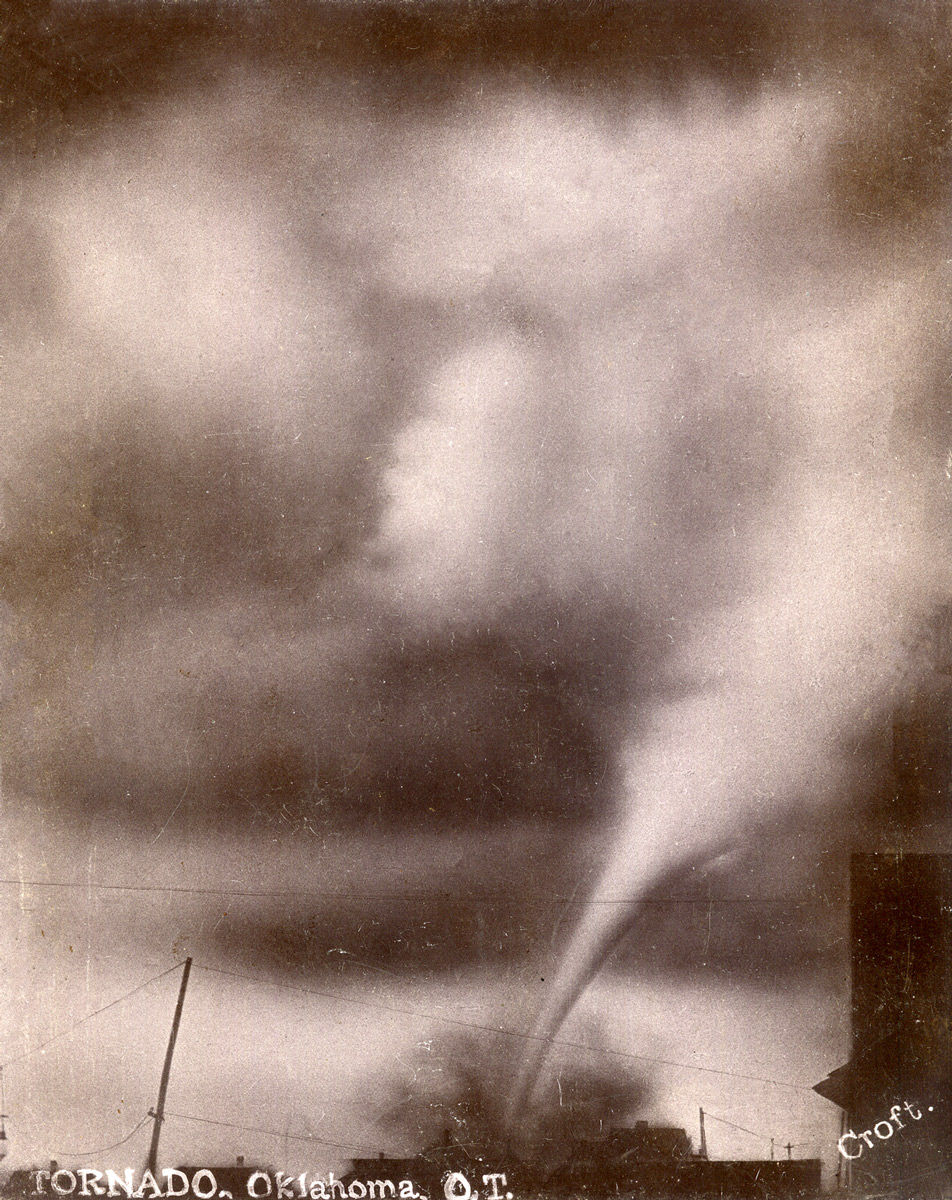TORNADOES.
The unpredictability and severity of Oklahoma's weather has been a hot topic of conversation since the Land Run of 1889 opened the Unassigned Lands of central Oklahoma to non-Indian settlement. Perhaps no single weather-related phenomenon has caused more dread and consternation than the tornado. Of an annual average of eight hundred tornadoes that are reported in the United States, most occur in "tornado alley," a corridor that extends from north Texas through the Sooner State, north through Kansas and Nebraska, and east into Iowa. Warm air from the Gulf of Mexico pushes north, even warmer air blows in from the southwest, and cold polar air surges eastward from the Rocky Mountains. When these air masses mix, the resulting thunderstorms can produce tornadoes.
Oklahoma's unique geographical location in the "eye" of tornado alley increases the likelihood of twisters. While they can occur in any month, most happen from April through June. In a 2002 historical study meteorologists at the National Severe Storm Laboratory at Norman analyzed weather and damage data from more than ten thousand tornadoes occurring between 1921 and 1995 and created computer models of the probability of twisters striking areas across the nation. The study pinpointed Pontotoc County in southeastern Oklahoma as the most likely spot for a tornado in the United States.
Early settlers of Oklahoma often had little, if any, warning of incoming "cyclones." If a funnel was spotted, officials would ring a church bell to alert area residents to seek shelter. More often than not, the tornado hit without warning. For example, on the morning of March 30, 1897, a ferocious tornado suddenly swooped down on the small Oklahoma Territory community of Chandler in present Lincoln County. A group of rowdies had been passing the time at Elmer's Saloon when the storm twisted its path over the wooden structure. At the peak of the storm the winds dislodged the establishment's walls, causing the roof to collapse on the patrons. One of the customers crawled out from under the debris, turned to the bartender, and asked, "Elmer, whoinell started that fight?" Unfortunately, many in Chandler had not been as lucky. Fourteen were killed, and hundreds of other were injured, several severely.
The two deadliest tornadoes to strike Oklahoma occurred on April 9, 1947, at Woodward and on May 10, 1905, at Snyder in present southwestern Oklahoma. More than one hundred were killed by each storm. Ironically, the warning system in 1947 had hardly improved since the 1890s. However, after a tornado smashed into Tinker Air Force Base near Oklahoma City on March 20, 1948, military authorities directed Maj. Ernest J. Fawbush and Capt. Robert C. Miller, two U.S. Air Force meteorologists at the base, to determine whether or not tornadoes could be forecast. Their endeavors resulted in the first publicly broadcast tornado forecast and warning, issued at Tinker for the air base on March 25, 1948.
This scientific feat laid the groundwork for future warning systems. Doppler radar, NEXRAD, satellite imaging, and storm tracking have replaced the school or church bell as a warning device. The National Oceanic and Atmospheric Administration selected Oklahoma as home of the National Severe Storms Laboratory and of the Storm Prediction Center. These, as well as the National Weather Service's Regional Forecast Center, are located at Norman.
Unfortunately, technology can only do so much to prevent casualties from twisters. A massive supercell storm on May 3, 1999, produced twenty-one tornadoes, devastating areas of the state from Lawton in the south to near Tulsa in the northeast. The largest, rated as an F-5 on the Fujita scale, spawned winds near 320 miles per hour, the most powerful ever recorded. The storms killed forty-four people, injured almost eight hundred others, and damaged or destroyed about eight thousand buildings. According to officials at the National Weather Service, had the giant tornado blazed through the Oklahoma City metropolitan area a few decades earlier, the death toll likely would have been much higher.
See Also
Bibliography
John Archer, Tornado! (Mankato, Minn.: Crestwood House, 1991).
Richard Bedard, In the Shadow of the Tornado: Stories and Adventures from the Heart of Storm Country (Norman, Okla.: Gilco Publishing, 1996).
Gary A. England, Weathering the Storm: Tornadoes, Television and Turmoil (Norman: University of Oklahoma Press, 1996).
Peter S. Felkner, The Tri-State Tornado (Ames: Iowa State University Press, 1992).
Gary Jennings, The Killer Storms (Philadelphia: J. B. Lippincott Co., 1970).
Leo Kelley, "Oklahoma: Home of the Real Twister," The Chronicles of Oklahoma 74 (Winter 1996–97).
Mike Males, "No Sound I Will Ever Forget: The Antlers Tornado of 1945," The Chronicles of Oklahoma 73 (Spring 1995).
Oklahoma Killer Tornadoes (Norman, Okla.: National Severe Storms Laboratory, 1980).
Sid Perkins, "Tornado Alley, USA," Science News, 11 May 2002.
Citation
The following (as per The Chicago Manual of Style, 17th edition) is the preferred citation for articles:
Leo Kelley, “Tornadoes,” The Encyclopedia of Oklahoma History and Culture, https://www.okhistory.org/publications/enc/entry?entry=TO008.
Published January 15, 2010
© Oklahoma Historical Society



